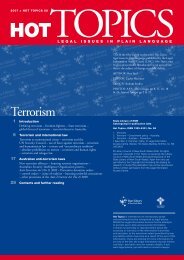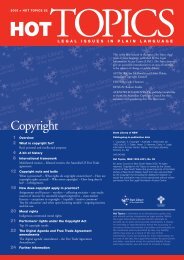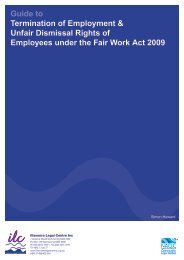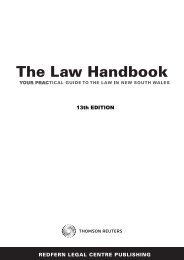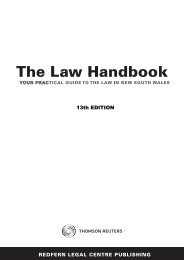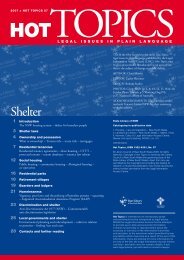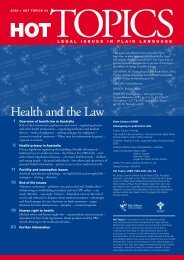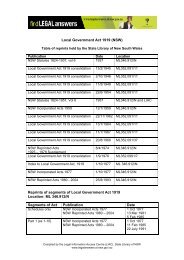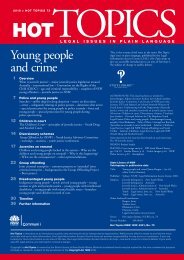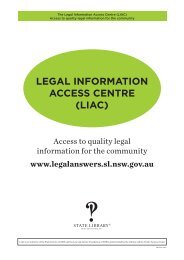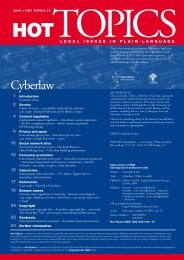Drugs and the law - Hot Topics 59 - Find Legal Answers
Drugs and the law - Hot Topics 59 - Find Legal Answers
Drugs and the law - Hot Topics 59 - Find Legal Answers
You also want an ePaper? Increase the reach of your titles
YUMPU automatically turns print PDFs into web optimized ePapers that Google loves.
LegislationUnder section 148 of <strong>the</strong> Law Enforcement (Powers <strong>and</strong>Responsibilities) Act 2002 police can use sniffer dogswithout a warrant to detect illicit drugs, but only for‘general drug detection’, defined to mean using a dog todetect <strong>the</strong> potential presence of drugs by smell, before<strong>the</strong> police conduct any actual search of <strong>the</strong> person or<strong>the</strong>ir belongings.sniffer dogs <strong>and</strong> warrantsPolice can use a dog to assist with general drug detectionwithout a warrant (Law Enforcement (Powers <strong>and</strong>Responsibilities) Act 2002, s 148), in relation to a personwho is at, entering or leaving:> premises licensed for <strong>the</strong> consumption of liquor sold<strong>the</strong>re (not including a restaurant or dining room)> a public place being used for ‘a sporting event, concertor o<strong>the</strong>r artistic performance, dance party, parade oro<strong>the</strong>r entertainment’> a train, bus or light rail vehicle, on a prescribed route,or a station, platform or stop.In o<strong>the</strong>r circumstances – for example, in a public street– police can only use drug detection dogs to searchpeople or vehicles with a warrant issued under <strong>the</strong>Law Enforcement (Powers <strong>and</strong> Responsibilities) Act 2002,section 149.A police officer is authorised to use a dog for generaldrug detection only as provided under <strong>the</strong> Act (LawEnforcement (Powers <strong>and</strong> Responsibilities) Act 2002,section 147).in <strong>the</strong> supreme courtIn DPP v Darby 10 <strong>the</strong> defendant was searched outsidea nightclub after a sniffer dog had indicated to policethat he was in possession of prohibited drugs. The courtruled that <strong>the</strong> sniffer dog’s activity did not amount to asearch. It found that <strong>the</strong> dog’s reaction was a basis forforming a suspicion by <strong>the</strong> police, just as informationfrom ano<strong>the</strong>r officer, or from a member of <strong>the</strong> public,or an officer’s own perceptions (for example, of a strongodour of cannabis) might be a basis for an officer to forma suspicion.Darby applied a 1998 South Australian Supreme Courtdecision – Questions of Law Reserved (No. 3 of 1998) 11 ,which came to a similar conclusion. In that case, <strong>the</strong> SASupreme Court decided that a dog sniffing a suitcase in<strong>the</strong> luggage compartment of a bus was not conducting asearch. Special leave to appeal this decision was refusedby <strong>the</strong> High Court. 12ombudsman’s reportThe NSW Ombudsman’s 2006 report on <strong>the</strong> introductionof <strong>the</strong> sniffer dog legislation was that drugswere found in only a quarter of cases where <strong>the</strong> dogshad indicated <strong>the</strong> presence of drugs, which suggests thatsniffer dog ‘indication’ may be of doubtful accuracy.The Ombudsman report also found that <strong>the</strong> use ofsniffer dogs had no apparent effect on apprehendingdrug suppliers, with less than 1% of <strong>the</strong> over 2000people found in possession after a search, successfullyprosecuted for supply.inTernal searcHesWhere <strong>the</strong> police suspect that a person has swallowedor is internally concealing a prohibited drug, <strong>and</strong> that<strong>the</strong> person has committed or is committing an offenceinvolving supply of a prohibited drug, <strong>the</strong>y may detain<strong>the</strong>m to arrange an internal search (Law Enforcement(Powers <strong>and</strong> Responsibilities) Act 2002, section 155).An internal search involves ultrasound, X-rays, MRI(magnetic resonance imaging) or some o<strong>the</strong>r form ofmedical imaging, but does not include intrusion intoa body cavity. It can only be done by a doctor or o<strong>the</strong>rqualified person.A child under 10 cannot be required to submit to aninternal search.Adult suspects are asked to consent to <strong>the</strong> search. Policemay apply to an eligible judicial officer for an order forinternal search <strong>and</strong> detention if:> <strong>the</strong> person refuses consent> is under 18, or> is incapable of giving informed consent.Where an internal search reveals <strong>the</strong> presence of anythingthat might be prohibited drugs, <strong>the</strong> person may bedetained for 48 hours. This period may be extended byan eligible judicial officer, but no more than twice unlessin exceptional circumstances.searcH friendA person is entitled to have a search friend present ata hearing of an application for an internal search, <strong>and</strong>during <strong>the</strong> search itself, if <strong>the</strong>y are:> under 18> incapable of giving consent, or> an Aboriginal or Torres Strait Isl<strong>and</strong>er.A search friend can be:> a parent or guardian> a legal representative> a representative of an Aboriginal legal aidorganisation> ano<strong>the</strong>r person chosen by <strong>the</strong> suspect.10. [2002] NSWSC 1157 (unreported)11. (1998) 71 SASR 22312. Hoare v The Queen (1989) 167 CLR 34818HOT TOPICS <strong>59</strong> > <strong>Drugs</strong> <strong>and</strong> <strong>the</strong> <strong>law</strong>



